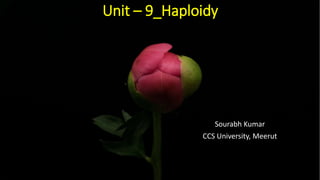
Haploid
- 1. Unit – 9_Haploidy Sourabh Kumar CCS University, Meerut
- 2. Outline • Introduction to Doubled Haploid (DH) technology • Production of Doubled Haploid (All methods) • Detection of Haploids • Uses of Doubled Haploid in Plant Breeding • Challenges • On-going activities
- 3. Chromosomal Aberrations A. Structural Aberrations oDeletion oDuplication oInversion oTranslocation
- 5. Inversion Paracentric Inversion A B C B A C B A A B C A B C Pericentric Inversion
- 6. Terminal Translocation Reciprocal Translocation Robertsonian Translocations
- 7. Karyotype of normal female & Male
- 8. B. Numerical Aberration (Heteroploid) I. Aneuploid: 1. Nullisomic 2. Monosomic 3. Double monosomic 4. Trisomic 5. double trisomic 6. Tetrasomic II. Euploid: 1. Monoploid 2. Haploid 3. Polyploid a. Autopolyploid b. Allopolyploid
- 9. What is a doubled-haploid plant? Each cell contains 2 sets of genetic information which are (but not exactly) identical most. For example, one gene set may carry a gene for disease resistance when the other set does not. Doubled haploid plant has cells containing 2 gene sets which are exactly identical. If one gene set has the disease resistance gene the other gene also having resistance. • Haploid: an individuals with the gametic chromosome number (n) in its somatic cells. • A Doubled Haploid: is a genotype formed when haploid cells (n), i.e. egg or sperm cell undergo chromosome doubling (2n). • The resulting individual is completely homozygous.
- 11. Fig. Classification of haploids
- 12. Based on the point in the life cycle involved, haploid production systems can be broadly classified in three main categories:- 1. Parthenogenesis and apogamy 2. Chromosome elimination and 3. Culture methods
- 14. Haploid
- 15. 1. Production of Haploids through parthenogenesis and apogamy a) Spontaneous – Zea, Linum b) Artifial treatment- i) Irradiation – Crepis, Triticum ii) Wounding/injury – Oenothera, Nicotiana, Zea iii) Temperature – Datura, Secale iv) Chemicals – Populus, Capsicum c) Delayed pollination – Zea mays d) Wide hybridization – Solanum tuberosum (pollinator S. phureja & other 33 species e) Alien cytoplasm – Chinese Spring f) Inducing genes- i) Indeterminate gametophyte (ig) – Zea mays ii) Haploid initiator gene (hap) – Hordeum vulgare g) Semigamy – Gossypium (4 species), Coix, Rudbeckia, Arabidopsis, etc.
- 16. a) Somatic reduction and chromosome elimination in Sorghum b) Barley haploids through crosses with Hordeum bulbosum c) Haploids of other Hordeum species from interspecific hybrids b) Wheat haploids through crosses with Hordeum bulbosum c) Wheat haploids from wheat x maize crosses 2. Production of Haploids through chromosome elimination
- 19. Wheat X Maize Detachment of wheat tillers Application of colchicine 24 hours after pollination with maize Shift tillers to tiller culture media and maintain under 16h light/8h dark condition for next 15 days at 20-220C Shift tillers 40C for three days Embryo rescue and culture on media Plant regeneration and shifting to soil after hardenning Protocol followed Emasculation of wheat spikes Steps in Generation of DH Population Wheat haploids from wheat x maize crosses
- 21. Centromeres are epigenetically marked by association with a centromere-specific histone H3 variant (CENH3)
- 22. • Satellite repeats often evolve rapidly, so it can be species-specific or it can be present in a group of closely related species. • Rapid evolution of centromeres adds an evolutionary argument that favors their involvement in uniparental genome elimination. • Centromere differences may be the reason behind infertility or lower fitness in interspecies hybrids • This would create reproductive isolation ultimately leading to speciation. Rapid evolution of centromeres
- 26. 3. Production of Haploids through anther and microspore culture
- 27. Factors affecting Androgenesis 1. Genotype of donor plant 2. Physiological status of donor plants 3. Stage of pollen development 4. Size of anthers 5. Anther wall factors 6. Culture medium 7. Growth Regulators 8. Cultured environment 9. Pre treatment of anthers 10. Dissection of anther 11. Orientation and density of anthers 3. Production of Haploids through ovule culture
- 28. Haploids can be identified by 1) Morphology 2) Bio-chemical studies 3) Marker genes linked with haploidy In general the haploids are much weaker highly sterile and difficult to maintain when compare to the normal plants of concerned species. Therefore chromosome number of all haploids are doubled usually by treating with colchicine to produce doubled haploids which have the normal somatic chromosome complement (2n) of the species and are fully fertile. Identification of haploids
- 29. DH-Donor (colorless) Inducer (purple embryo & aleurone) Haploid seed - colorless embryo - purple aleurone Regular (diploid) F1 seed purple embryo - purple aleurone X Haploid Kernel Identification Diploid embryo (purple scutellum) R1-nj color marker system for identification of haploids Morphological observation Triploid endosperm (purple aleurone) DNA finger printing
- 30. Uses of Double haploids in Crop Improvement
- 32. Pre-requisites for QTL Analysis 1. Mapping Population (DH) 2. Genotypic data 3. Phenotypic data 4. Marker Linkage Map 5. Appropriate software packages QTL Analysis QTL:- A gene/set of genes or genomic regions associated with the expression of a quantitative trait ; referred to as Quantitative Trait Locus(QTL).
- 33. Heat tolerant genotype Heat susceptible genotype × F1 DH population BC1 and BC2 Phenotyping Genotyping QTL analysis Marker Assisted Backcrossing (MABS) QTL analysis and MAS program for heat tolerance
- 34. Shortens the breeding cycle in a Normally, hybridization programme evaluation of lines is pedigree it takes possible years breeding another only after 4-5 of and 4-5 years to release a new variety. By anther culture of F1 hybrids the various genotypes of gametes can be fixed and evaluated in the first generation
- 35. Double haploidy with marker assisted selection
- 37. THANKS FOR CAREFUL LISTENING